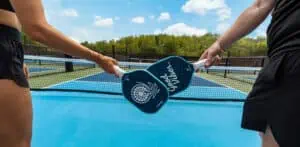Pickleball
How to Choose the Right Pickleball Paddle: A Complete Guide for Beginners

If you’re looking to dive into the thrilling world of pickleball, one of the first decisions you’ll face is what paddle to choose. With so many options out there, it can feel a bit overwhelming. But don’t worry! Picking the right paddle doesn’t have to be stressful. This guide is designed specifically for beginners like you, breaking down everything from weight and materials to grip size and price. You’ll soon discover how these factors can enhance your gameplay and help you feel more comfortable on the court. So let’s get started on finding that perfect paddle that will support your journey to becoming a better player!
When choosing the right pickleball paddle, key factors to consider include weight (lighter paddles offer better control, while heavier ones provide more power), grip size (ensure it feels comfortable in your hand for optimal handling), and paddle material (composite paddles typically enhance performance). Additionally, it’s important to assess your playing style—whether you prioritize power or control—along with the shape of the paddle, which may affect your reach and shot placement.
Pickleball Paddle Materials
The material of your racket plays a pivotal role in shaping your playing experience. When you step onto the court, you want to feel confident and at ease with your equipment. This confidence often stems from understanding the materials that make up your paddle. Each material comes with its own set of attributes, suited for different styles and levels of play.
Common Materials Explained
When it comes to pickleball paddles, the material you choose can dramatically influence your gameplay. The four most common materials are wood, fiberglass, graphite, and carbon fiber—each offering distinct advantages depending on your skill level, playing style, and preferences.
Wood Paddles
Wood paddles are the most traditional and affordable option, often priced between $20–$50. Known for their durability, they’re ideal for casual games or beginner players testing the waters. However, they tend to be heavier, which can lead to fatigue during extended play and reduced maneuverability. While they lack the finesse and responsiveness of modern materials, wood paddles can still be a solid starting point for recreational play.
Fiberglass Paddles
Fiberglass paddles are often grouped under composite paddles and strike a balance between performance and price. These paddles usually feature a polymer or honeycomb core paired with a fiberglass surface, offering a combination of power and control. They’re a great choice for intermediate players looking to improve consistency and spin. Popular models like the Selkirk Latitude deliver excellent all-around performance and are well-suited for a wide range of playing conditions.
Graphite Paddles
Graphite paddles are popular for their lightweight build and quick response time. These paddles are ideal for players who value precision and speed, especially at the net. The Onix Graphite Z5, for instance, is a go-to paddle for many competitive players due to its blend of touch and control. While they tend to be more expensive, graphite paddles offer a serious performance upgrade for those advancing their game.
Carbon Fiber Paddles
At the high-performance end of the spectrum, carbon fiber paddles offer unmatched stiffness and responsiveness, making them a favorite among elite and tournament-level players. Carbon fiber paddles provide exceptional control, reduced vibration, and a crisp, clean feel on contact. They are often considered an upgrade from graphite, thanks to their strength-to-weight ratio and consistency. These paddles typically come at a higher price point but deliver top-tier results for serious competitors.
Choosing the Right Material
The difference between a beginner’s frustration and an expert’s finesse often comes down to paddle material. Understanding these materials is essential for choosing a paddle that enhances both your comfort and effectiveness on the court.
Next, we’ll explore how paddle weight plays a crucial role in performance—and how to find the right balance for your playing style.
Choosing the Right Weight
When selecting a pickleball paddle, the weight you choose will significantly impact your gameplay. A paddle’s weight plays a pivotal role not only in performance but also in how tired your arm feels after a long session on the court. If you’ve ever played with a heavy paddle for too long, you know the strain it can put on your wrist and shoulder. It becomes crucial to match your playing style and physical condition with the appropriate weight category.
Weight Categories
As mentioned, paddles come in three main weight categories: light, medium, and heavy, each catering to specific player preferences and styles of play.
Light paddles, weighing 7.3 ounces or less, excel in allowing swift maneuvers during intense exchanges. These paddles are perfect for players who flourish in fast-paced dinking scenarios where quick reflexes at the net are pivotal. Having this lightweight option enables you to react instantly, volley efficiently, and maintain control without feeling bogged down.
However, if you find yourself gravitating toward all-court play requiring varying degrees of control and power, mid-weight paddles may be your ideal fit.
Mid-weight paddles, falling between 7.4 and 8.4 ounces, offer a harmonious balance between power and control. This versatility makes them particularly popular among beginner to intermediate players, as they allow room for growth while you refine your skills. Whether you’re smashing from the baseline or delicately placing shots near the net, these paddles adapt well without overwhelming you physically.
| Weight Category | Weight (oz) | Characteristics | Recommended For |
| Light | <7.3 | Easy control, less fatigue | Net play, quick reactions |
| Medium | 7.4-8.4 | Balanced power and control | All-round play |
| Heavy | >8.5 | Maximum power, more tiring | Baseline play, power shots |
On the flip side are heavy paddles that exceed 8.5 ounces. They are lauded for delivering maximum power—perfect for those looking to develop their strength and dominate against opponents. However, wielding a heavy paddle can lead to quicker fatigue and may necessitate greater stamina on your part to sustain competitive play over an extended period.
Ultimately, when choosing your paddle’s weight consider not only your playing style but also how much comfort you desire during matches; that’s where considerations regarding grip feel become essential for optimizing your overall pickleball experience.
Handle Comfort and Grip Size
The comfort of your paddle’s handle can profoundly impact your game. If it’s too large or too small, it affects not just how well you control the paddle but also your endurance during play. When you grip something comfortably, your body naturally performs better. Just like wearing shoes that fit perfectly allows you to walk or run with ease, a well-fitted grip enhances your swing mechanics, enabling fluid motion without unnecessary strain.
Assessing Grip Size
Grip size is essentially the circumference of the paddle handle, and choosing the right one is crucial. An incorrect grip size can lead to discomfort, hinder performance, or even result in injuries such as tennis elbow over time. You wouldn’t wear a dress shoe while running a marathon—so why would you choose a paddle that doesn’t fit correctly?
Measuring Grip Size
To determine your ideal grip size, measure from the middle crease of your palm up to the tip of your ring finger. Typically, this measurement will fall within an array of options, generally between 4 and 4.5 inches. Think of it as finding the right shoe size: if it’s too tight, it causes discomfort; if it’s too loose, you lose control.
In case you don’t have a measuring tool available, there’s a handy method you can try using an ordinary paddle. Hold it in your dominant hand with a firm grip. If there’s enough space that the index finger touches the base of your thumb, then it’s likely too big. Conversely, if you’re reaching too far toward the end and feel like you’re straining somewhat to hold on securely—it’s likely too small.
Impact on Gameplay
Your choice in grip size can affect gameplay significantly. Smaller grips allow for more wrist action, which translates into better ball control and spin capability, making it easier to generate impressive topspin shots—a crucial factor in outsmarting opponents. On the flip side, larger grips offer greater stability and help in providing comfort during those long matches; they are easier on the arm but tend to limit some wrist flicks that contribute to finesse shots.
It’s important to find that sweet spot where comfort meets capability because ultimately, having control over where and how you direct the ball sets apart casual players from those who truly excel on the court.
By measuring properly and adjusting your preferences according to what feels best in your hands, you’ll set the foundation for enhanced performance in your game while exploring additional factors that contribute to effective gameplay.
Surface Texture Impacts Performance
The surface texture of your pickleball paddle isn’t just an aesthetic choice; it plays a pivotal role in how well you can control your shots and execute your plays. When choosing a paddle, consider how its surface will affect your overall game. Each type of texture provides unique advantages, so understanding these differences can steer you toward the option that fits your style best.
Types of Surface Textures
Smooth surfaces are often favored by players who focus on power. These paddles allow for quick shots but offer less spin, which might suit those who prefer a straightforward approach. Power players benefit from their ability to strike the ball quickly, harnessing momentum without being bogged down by excess grip. Think of this as wielding a sword: it’s sleek and reliable for direct attacks, but it’s not necessarily designed for intricate maneuvers.
Textured surfaces bring a different mastery to the table. They enhance ball spin and improve shot accuracy, making them ideal for strategic players who value precision. The most effective textures incorporate advanced materials like Kevlar or carbon fiber, which means they can better manage wear and tear while providing superior feel and responsiveness. As you begin to experiment with these paddles, you might notice that those with rough grit finishes or raised bumps allow you to impart significant spin on the ball, altering its trajectory and tricking opponents.
This strategic advantage becomes even clearer when considering how surfaces interact during play. A well-textured paddle allows you to manipulate the ball’s motion effectively, giving you an edge in competitive settings.
Whether you want more spin or more power should guide your decision regarding surface texture. If you’re drawn to aggressive gameplay that demands quick responses, smooth paddles may feel most natural. Conversely, if you’re enticed by spinning shots that deceive others and create openings in their defense, textured paddles could prove to be the secret weapon in your arsenal.
Carefully evaluating surface texture isn’t merely about preferences—it’s about understanding how each choice impacts your strategy on the court. Let’s now explore how different skill levels influence the features you might seek in a paddle.
Matching Skill Level to Paddle Features
When it comes to pickleball, not all paddles are created equal, and one of the main reasons is the player’s skill level. A beginner may find certain paddle characteristics more beneficial than others. If you’re just starting out, you want a paddle that provides a friendly experience, allowing you to get comfortable with the game without feeling overwhelmed. This is why beginners should prioritize paddles with a larger sweet spot, which can help deliver better shots even when striking off-center. Additionally, lighter paddles provide easier maneuverability, giving newbies confidence as they develop their swing.
Beginner Recommendations
Beginners stepping onto the court for the first time often do well with mid-weight composite paddles, which blend power and control quite effectively. These paddles aren’t so heavy that they tire you out nor so light that you feel a lack of control. A balanced design fosters an enjoyable learning experience; this is crucial when you’re still figuring out the game’s nuances. The idea here is simple: find something that feels good in hand while aiding your ability to manage the ball effectively on your side.
As someone who took their first steps into pickleball with a composite paddle, I can vouch for how it eases the learning curve and encourages players to focus rather than fret.
Intermediate and Advanced
As players progress beyond the beginner stage, their skill sets evolve, prompting them to seek specialized paddles catering to advanced dynamics. At this level, many players gravitate toward graphite paddles, known for their enhanced balance, responsiveness, and accuracy. These paddles generally allow for more powerful hits without losing delicate touch during strategic plays. An experienced player can then benefit from adjusting their paddle choice based on individual playing style or preferences—whether it’s prioritizing speed or aiming for control.
“Switching to a graphite paddle improved my game drastically,” recalls Ruth, an intermediate player. This statement resonates with many who opt for lighter materials as they refine their technique and look to enhance specific aspects of their performance.
Understanding how different paddle features synchronize with your growing skills opens up exciting possibilities on the court. Transitioning from basic choices to more tailored options marks an important step as you continue your journey in the sport.
Price Considerations for Beginners
For newcomers stepping onto the pickleball court, understanding how much to spend on a paddle can make a significant difference. Thankfully, diving into this sport doesn’t require breaking the bank. In fact, with some smart purchasing choices, you can secure a great paddle without stretching your wallet too thin. Isn’t that reassuring?
Budget Breakdown
It’s wise to target budget options that range between $50 and $100. This price range often delivers a fantastic balance of cost and performance while ensuring durability for those who are just starting out. After all, plenty of people worry that picking the wrong paddle could ruin their gameplay. However, brands like Onix and Gamma have developed starter paddles in this category that provide impressive features at attractive prices.
When considering your purchase, here are a few affordable models worth investigating:
- Onix Recruit ($50): A classic choice known for its quality and suitability for first-time players. It’s lightweight, easy to handle, and helps develop skills without overwhelming complexity.
- Gamma Fusion ($70): This paddle strikes a perfect balance between power and control, making it an excellent option as players begin to refine their techniques.
- Head Radical Pro ($90): Offering a premium feel without the elevated price tag, it fits nicely into the hands of transitioning beginners mastering their game while still being budget-conscious.
In addition to looking for the right brand and model, consider leveraging promotional codes or sales when purchasing paddles; many vendors offer discounts or seasonal sales that could save you money. Keep an eye out for bundles as well—often, buying multiple paddles can lead to significant savings.
Being mindful of your budget doesn’t mean sacrificing quality; instead, it means being strategic about where you invest your resources. With these recommendations in hand, you’re now better equipped to explore paddle options confidently as you prepare to enhance your pickleball experience!
If you’re ready to plan the perfect Pickleball getaway, don’t hesitate to reach out! For any questions or personalized assistance in booking your all-inclusive Pickleball vacation, contact us at VibeGetaways or call us at 262-891-4768.
More Articles
Pickleball: The Perfect Family Vacation Activity for Outdoor Fun and Bonding
Looking for a fun way to get the whole family outside and active on your next vacation? Pickleball might be…
Read MorePickleball History and Popularity: From Backyard Roots to a Global Sport
Pickleball started as a simple way for friends and family to have fun together, but today it’s become much more…
Read MoreVacation Planning Tips & Tricks: Your Ultimate Holiday Checklist for 2025
Planning a vacation might seem as simple as booking a flight and packing a bag, but anyone who’s ever felt…
Read More5 Secrets to Stress-Free Vacation Planning: The Ultimate Guide to Easy Travel
Planning a vacation should be exciting, not stressful, but all too often it feels like a juggling act, with flights,…
Read More


